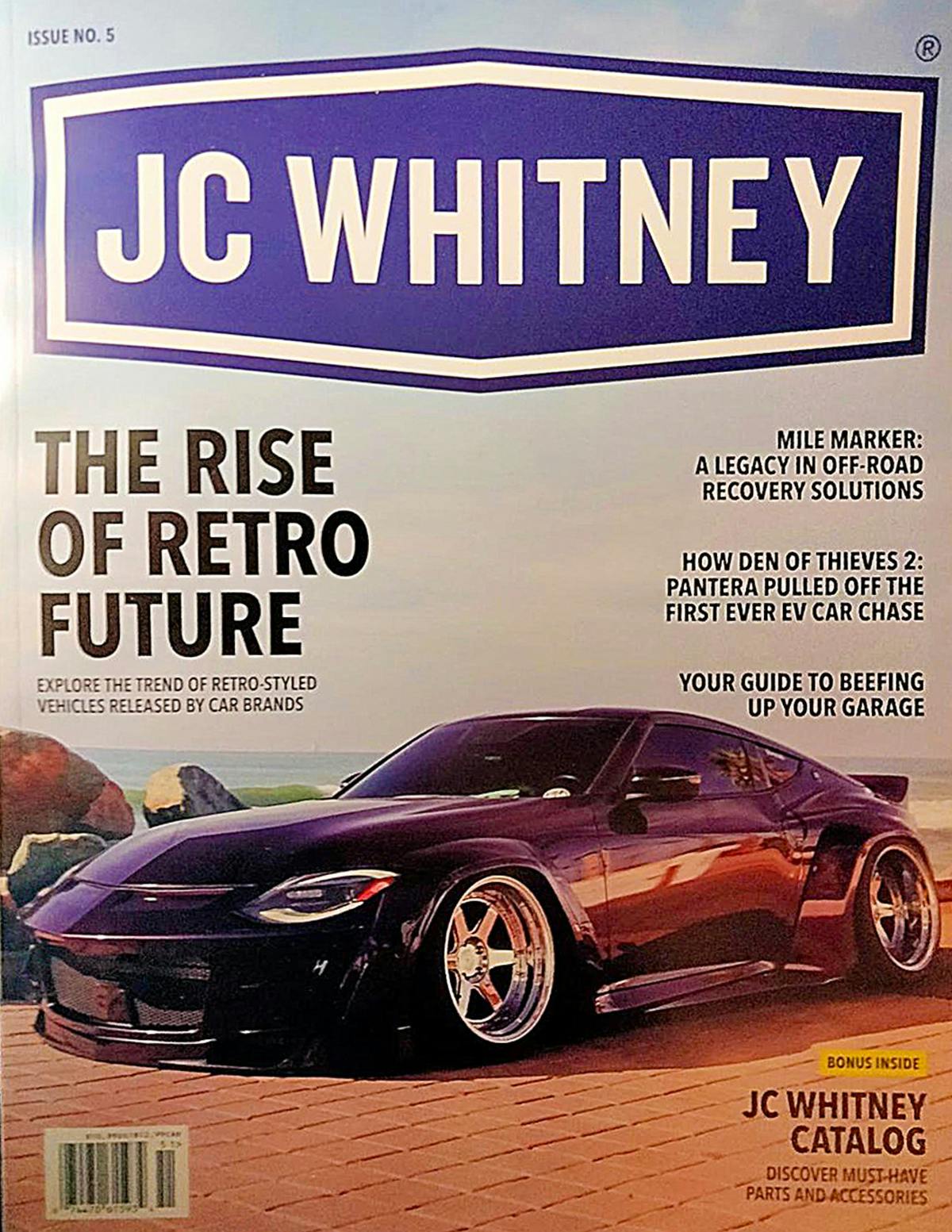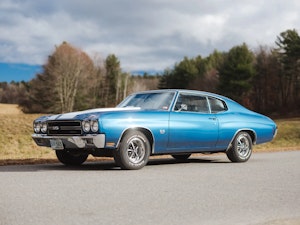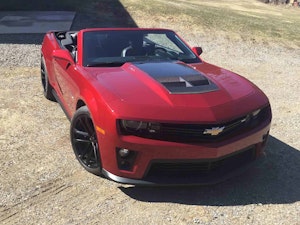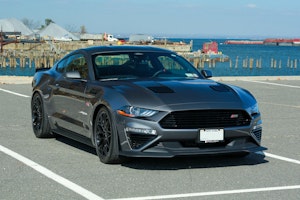Media | Articles
J.C. Whitney Lives! Well, Sort Of. But It Definitely Isn’t the Same.
There was no one at J.C. Whitney whose name was actually J.C. Whitney. But there was Winky the Cat, my Most Unforgettable Character from my youthful years of thumbing through Whitney catalogs, when I would have been better served by thumbing through textbooks for a change. It took weeks for me to decide what custom exhaust I should bolt onto my Volkswagen Beetle, which was my first major custom-auto purchase, and during that period I treated the J.C. Whitney catalog with the same somber respect due to, say, The Congressional Record.
The Whitney catalog was available on magazine racks in drug stores, and was cheap enough that any kid could afford it. And why wouldn’t it be? Whitney was perhaps the first marketer who realized that people would actually pay for a publication that was nothing but advertisements. Plus, it couldn’t have been expensive to print, judging from the fact that it was all in crude black and white and printed on paper just one step up from toilet tissue. The people at J.C. Whitney wrote all the copy and laid it out, before it went to the place that also prints—or printed, since they no longer exist—your local phone books.
You could even subscribe to Whitney for free, but it didn’t take long for the company to figure out that you likely weren’t old enough to actually buy anything, and you were back at the drug store paying for it again.

Anybody younger than—what, 40?—is too young to remember the actual catalog, but the name J.C. Whitney still resonates in our jargon, such as, “Man, where did you buy that ridiculous chrome coffee-can tip for your exhaust? J.C. Whitney? Hahaha!” That dig was pretty much interchangeable with “Pep Boys,” though Manny, Moe and Jack have cleaned up their act considerably.
It is difficult to describe to those who weren’t around then how much stuff Whitney sold that you’d never be caught dead with on your car. Ah-ooga horns, an Ocean Liner Blast horn, fuzzy dice, mud flaps, a Continental kit, a Hollywood muffler; this was during a period when your wealthier neighbor might have whitewall tires on his car, a sign of prosperity, so Whitney sold a Whitewall Kit, which contained “pure colloidal white rubber (not a paint)” so you could “make whitewalls out of plain black tires.” It included a brush, a cleaner, and two cans of colloidal white rubber for $2.39.

In later years, Whitney kept up with the times, stocking merchandise that was important to its up-and-coming customers. Such as the fake cellular phone antenna, which stuck to your car’s rear window, signaling to the world that you were connected. Want to take it a step further? It offered fake cellular phones, so at a stoplight, you could act as though you were lining up a date or closing a big deal, for the benefit of those who came to a stop next to you and glanced over.
And, through it all, or most of it, at least, there was Winky the Cat (which I always thought would be the name of my band), described here in the catalog: “Lovable-looking stuffed cat has acrylon-like fur and satin bow. Sits on rear window ledge. Automatic operation—hooks up easily to directional wiring. Eyes light up when brakes are applied, blink on and off with directional signals. 17 inches long.” It cost $4.98. Two red replacement bulbs for Winky’s eyes were 69 cents. (There’s an original, creepy-looking, in-the-package Winky on Etsy.com for $595, a markup of $590.02. In 1967, a share of IBM stock sold for $3.14. Today, it would be worth, well, $1,173,000. Okay, so it was a better investment than Winky, but still…)

Winky was, it almost goes without saying, a clever precursor to the Center High-Mounted Stop Lamp, or CHMSL, mandated by the National Highway Traffic Safety Administration in all new cars sold in the U.S. since 1986. “Winky’s eyes warn the car behind you,” it said on the packaging. “The overall presentation of the entire package is SWEET!,” says the Etsy seller, who offers a variety of cat-centric collectibles.
During my visit to the J.C. Whitney headquarters in Chicago, I asked Gene Geiger, the purchasing manager, about Winky, who had suddenly disappeared from the catalog. The news was not good.
It wasn’t Winky who died, he told me, but his inventor, “an elderly man on the East Coast who would buy the stuffed cats, poke out the eyes, replace them with bulbs and wire them up for 12-volt.” One day, Geiger received a phone call. It was the daughter of Winky’s creator. She informed Geiger of her father’s passing and said she didn’t much want to keep making Winkys. “Toward the end, we were only selling a few thousand Winkys a year anyway,” Geiger said, though that seems like a lot of electrified cats.
Marketplace
Buy and sell classics with confidence
The company that became J.C. Whitney was founded in 1915, meaning this year marks its 110th birthday. It was developed on the south side of Chicago by Israel Warshawsky, a Lithuanian immigrant who began salvaging junk cars and selling the parts, typically every nut and bolt. The business was called Warshawsky & Co. Its growth was spurred by World War I, during which Warshawsky injected himself and his firm into the Liberty Bond campaign. At a Chicago fund-raising rally, Army tanks smashed cars supplied by Warshawsky. At a vaudeville theater, Sophie Tucker, an immensely popular singer and comedienne known as the “last of the red-hot mamas,” saluted the recycling initiative with a song called, “I’ve Got a Car That Warshawsky’s Turned Down.”
Not surprisingly, Warshawsky & Co. thrived during the Great Depression, when America’s automotive emphasis was to wring a few more miles out of your current car, and Warshawsky had spare parts for everything. By 1933, Warshawsky began publishing a catalog for its salvaged parts. Covers declared: “The century’s greatest VALUES!” He offered Ford Model A cylinder heads for $3.15.
Only one of Israel’s children had much interest in the family business, and that would be Roy, who had just graduated from the University of Chicago. He went to work at the company, and by 1937 had convinced his father that it would be a good idea to expand the catalog, adding new parts to the salvaged ones that they already advertised. He pushed to have the catalog distributed outside Chicago to create a mail-order demand. Although the company was always known in Chicago as Warshawsky & Co., Roy gave the catalog a different name: J.C. Whitney & Co. “In those days, you needed a less ethnic, Anglo-Saxon name,” said Whitney vice-president John Armstrong when I interviewed him in the 1990s.
But why J.C. Whitney? No one knew—not even Roy’s family. “We can’t get it out of him,” said Carol Warshawsky Steinberg, Roy’s daughter and chairman of the board from 1990 to 2002. There’s some evidence that “J.C.” may stand for “Jesus Christ,” and “Whitney” may be some sort of nickname Roy had in college. But as “Rosebud” was to Citizen Kane, it seems the “J.C. Whitney” name may remain a great unsolved mystery in the auto parts world.
Regardless, Whitney flourished under the strong hand of Roy Warshawsky. He hired Armstrong in 1973 to computerize the company. Shortly after Armstrong arrived, a longtime employee asked him if he’d seen the official Whitney chain-of-command chart. Armstrong said he hadn’t. “So the guy grabbed a piece of paper, drew a box on it, and inside wrote Roy’s name. ‘That’s it,’ he said. And how true that turned out to be—700 people in the company, and they all reported to one man,” said Armstrong.
“That’s the way he ran it. He made all the decisions. He had an endless menu of ideas—eight out of 10 weren’t any good, but the other two were fantastic. And those two kept us going.” Roy hated the media and rarely gave interviews, and when he did, they were short and sweet. He had a penchant for hanging up on reporters.

It’s difficult to overstate the importance of the J.C. Whitney catalog back in the day, especially if you lived in a rural area. Despite the fanciful merchandise Whitney offered, there were pages and pages of legitimate replacement and upgrade products, sometimes acquired from top-line manufacturers that would participate in a discounted plain-label program. There were always rumors that at the catalog’s peak, you could build an entire Jeep from mail-order parts.
Automotive writer Jim Donnelly wrote a thoughtful remembrance of Roy Warshawsky for Hemmings a few years ago. Like so many enthusiasts of a certain age, Donnelly recalls J.C. Whitney fondly. “When I was an adolescent,” Donnelly told Hagerty, “there were two days you anticipated eagerly every year: One was when Oscar Koveleski shipped out his Auto World catalog of model kits and slot cars, and the other was the day the thick, pulpy J.C. Whitney catalog landed in the mailbox. Both, though especially J.C. Whitney, were the stuff of days spent dreamily browsing.”

In February 1991, Roy suffered a stroke. The company had been set up so that if Roy became incapacitated, control would pass to his two daughters, Carol and Ilene, and to Roy’s wife, Sarita. The three combined for one stockholder vote, which meant, Armstrong said then, “that they win every decision by a vote of one to zero.”
Carol worked her way up, beginning in the advertising department, writing those little product blurbs. “I remember the first piece of copy I had to write for the catalog,” she told me. “It was for this little scantily-dressed Kewpie-doll air freshener. I thought, ‘What in the world can I say about this?’ From a woman’s point of view, I found it completely offensive. But somehow, I found something to say about it.”
When I visited, Roy’s old office was occupied by the computer that controlled the store’s operation. Efficient and up-to-date, perhaps, but you can bet the computer never had two good ideas out of every 10.
As the online universe blossomed, so did the proliferation of neighborhood auto parts stores, and businesses like J.C. Whitney suffered. In 2002, it was purchased by the Riverside Company, a private equity firm, and the inevitable downsizing began. Eight years later, a company now known as Carparts.com acquired J.C. Whitney, and dovetailed it into Carparts. They did, however, restore the JCWhitney.com site, and started the quarterly JC Whitney magazine, which is actually an odd mashup of magazine and catalog. “Buckle up!” it says on the website. “Flip to the JC Whitney catalog section for exclusive deals on top-notch parts, giving you that nostalgic shopping vibe with a modern twist.”
There’s really nothing nostalgic about it. It’s mostly just a slick packaging of unbylined stories and ads for the Carparts.com inventory, and it’s priced at a healthy $10.99 per issue. I bought it in hopes that it would remind me of the old J.C. Whitney catalog. It didn’t.

“You can’t go home again,” wrote Thomas Wolfe, and truer words were seldom spoken. I spoke to Gary Rovansek, who was president of J.C. Whitney from 1994 to 1998, during his first year in the job, and even then he was sounding the alarm. In his younger days, Rovansek was a Whitney customer, buying custom parts for his 1950 Oldsmobile.
But, he said, kids don’t customize cars today, or even perform much repair work themselves anymore. Today’s cars are too sophisticated. So are the kids. “I have two sons in their twenties, and I never see them working on their cars the way I did,” Rovansek said. Emphasize did, past tense. Rovansek said that he was driving a new Mercedes C-class, “and I can barely figure out where to pour in the windshield-washer fluid.”
“That’s of concern to us because if the average population is aging, then so is our customer base” said John Armstrong, then the company vice-president, when I spoke to him in 1994. “Our customers used to be the guys who were 18, or 20, or 22, and when they went to bed at night—if they didn’t have a girlfriend—they took our catalog. Now, that’s not so much the case.”
So the catalog died, and so did the massive, wood-floored Warshawsky & Co. retail store, where six creaky old buildings were connected and business was carried on seven days a week, serving customers who just wanted a few more miles out of their Impalas and Galaxie 500s, often making repairs where they parked, right there on the street. Near the end, “The store was run like a poor stepchild,” Armstrong said, “but it’s a national landmark, whether the government recognizes it as such or not.”
It didn’t, and it doesn’t. But the memories linger.
“Even if you just gazed at the inventory, you just knew that some of Whitney’s merchandise would make your ride—and you—hipper, cooler and an automotive standout in general,” recalls writer Jim Donnelly. “It was all about being different. Isaac and Roy Warshawsky were undeniable visionaries, and every one of the performance or accessory warehouse stores doing big business today owes these two pioneers a debt of gratitude for inventing their industry.”

















In the early 70’s, I bought a set of no-name tube headers and complete dual exhaust system from them for my ’56 Ford Parklane wagon, 312V8. Everything came in one big box (except mufflers, I source Smittys’ locally because JCW just offered generic glasspaks). Came by Railway Express.
Good quality stuff, fit well, all installation parts (clamps, nuts/bolts, gaskets, etc.) were included. Installed in the yard, 2 floor jacks, 2 jack stands, some cinder blocks!
Another legendary company long since gone-Railway Express Agency (REA).
They had a major terminal in Chicago about a mile west of Warshawsky’s.
Only place I could find rings and rod bearings for my Sunbeam Alpine basket case. Got it going again!
Ordered fiberglass fender flares and other stuff for my Datsun 260Z in 1979. Instead of the $100 worth of parts ordered, I received a letter stating JCW had filed for bankruptcy protection and I was listed as a creditor. Never did get the parts or anything from the bankruptcy. Also never ordered from them again. $100 was a lot of money for an E4 in 1979.
Anybody remember B.S. Wisnewski auto parts south side of Milwaukee. No catalog but used to stock parts for old cars. Parts counter was in the basement of an old factory. Condos now. Whitlock auto parts ? Returned 3 rebuilt starters in one day to Whitlock. Spent the few extra dollars and went to Napa auto after 3rd one. Good times
How about Honest Charley’s Speed Shop, Chattanooga, Tennessee (complete with a picture of “Honest Charley, hisself.”
Yeah, I’d like to see a story written about Honest Charley!
The “RockAuto” of the day, but with more accessories! I built my first Rambler in the 79-80 time frame using a lot of JCW parts, mostly accessories. If I couldn’t get it locally it came from JCW. Those were the last good days of the company when they still published a full catalog. I used that to find and compare prices like I use the RockAuto site now. If only mail order places like JCW and Sears had rolled their catalogs into Internet sales they’d probably still be here! Missed opportunities…
JC Whitney was my “Go To” source for parts as a kid. I bought rusted out beater 49 and 50 Plymouths and Dodges for no more than fifty bucks, bought rocker panels and seat covers for another fifty bucks from Whitney, had Earl Shibe paint them for $19.99 Late Show ad special, and sold them for $250.00. That was my High School and College income. Couldn’t have done it without JC Whitney!
I was picking up running boards at Warshawsky’s, walking out the door with two huge boards in hand I was robbed, right in front of the place, bought many parts from them but after that wouldn’t go down there, this had to be early seventies.
Yup-rough neighborhood.
In the early 80s I worked at a service station out in the Chicago suburbs. I towed a pretty fair number of stolen/stripped Cutlasses and Regals out of that neighborhood. A skinny white kid waaay out of my element down there, but I remember some of the rougher crowd (most residents were just good people in bad circumstances) giving me a wide berth as I worked. A few years later I came to the realization that in the city, virtually all tow truck drivers were armed and they were actually afraid of me.
Like the author, my first purchase from JC Whitney was headers for my Beetle – Flugger Hush Power that instantly added 10 horse power to my stock 40 horsepower engine. Not. The next purchase was twisted highway pegs for my motorcycle that looks just fine until compared to the quality pegs my buddy had. His had more twists and better chrome. While cleaning out the attic of my childhood home last summer I found the pegs and the box from the headers. Now, I’m a geezer with a Jeep and would love to thumb through the Whitney catalog to find a little more horsepower and some cheap chrome for my 150 CID inline 4. But sadly Whitney no longer exists. Anyone want to buy a beautiful 1984 piece of Americana.
Like the author, my first purchase from JC Whitney was headers for my Beetle – Flugger Hush Power that instantly added 10 horse power to my stock 40 horsepower engine. Not. The next purchase was twisted highway pegs for my motorcycle that looked just fine until compared to the quality pegs my buddy had. His had more twists and better chrome. While cleaning out the attic of my childhood home last summer I found the pegs and the box from the headers. Now, I’m a geezer with a Jeep and would love to thumb through the Whitney catalog to find a little more horsepower and some cheap chrome for my 150 CID inline 4. But sadly Whitney no longer exists. Anyone want to buy a beautiful 1984 piece of Americana.
Aw yes the JCW brick fake phone, “ Status without the Static”. My dad always got a kick out of that.
My favorite item was the catalytic converter tester. You install it in place of the converter and if the performance improves you know the converter is bad and you should replace it. “Yeah right” wink, wink, it was a straight thru pipe.
Amazed you didn’t mention what to me as a kid (yeah, I’m over 40) was among Whitney’s MOST memorable products: the novelty labels to hang on VW Beetle switches to identify their function. In pidgin German.
Drizzleflippen = wipers
Glimmerblinken = lights
Puttersparken = ignition
Warmercougher = choke,
Schmokegedunka = ashtray
Sadly, my dad raised an eyebrow in contempt and returned to his newspaper when excited 12-year-old me suggested these would be perfect for our new VW Squareback. (Nor would he buy + install the VDO tach that replaced the clock in the third instrument pod, but it was $40 and that was a LOT of $$$ then.) But I digress …
I looked forward to reading the J.C.Whitney catalog! I’ve still got an old J.C. Whitney Jeep parts catalog in the basement somewhere. It was the adult equivalent of the back of comic book ads. I ordered a lot of parts from J.C Whitney over the years for my ‘67 Firebird including a front spoiler, new soft top for my ‘73 MGB, chrome valve covers for my son’s ‘75 Dart, and yes an OOAGAH horn for my ‘74 Gremlin!
Thank you for the “now you know the rest of the story” story. This is Americana for boomers who graduated from go-karts and minibikes to our first rides. Flex exhaust tubing was a staple for my dual exhaust V-8 growing up in the NYS salt belt. Never opted for the curb feelers
The feeling of walking back from the mailbox with a freshly printed catalog and an afternoon that is now reserved for automotive daydreaming, is an experience that won’t return. It’s filed away along with strolling the aisle of Pep Boys memorizing the descriptions of Hella Fog lights and comparing them to PIAA driving lights. Or spending hours in the Craftsman section of Sears looking at tools you can’t afford and don’t quite know what they are designed to fix.